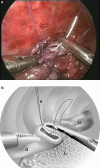Learning curve of thoracoscopic repair of esophageal atresia
- PMID: 22584690
- PMCID: PMC3414695
- DOI: 10.1007/s00268-012-1651-8
Learning curve of thoracoscopic repair of esophageal atresia
Abstract
Background: Thoracoscopic repair of esophageal atresia is considered to be one of the more advanced pediatric surgical procedures, and it undoubtedly has a learning curve. This is a single-center study that was designed to determine the learning curve of thoracoscopic repair of esophageal atresia.
Methods: The study involved comparison of the first and second five-year outcomes of thoracoscopic esophageal atresia repair.
Results: The demographics of the two groups were comparable. There was a remarkable reduction of postoperative leakage or stenosis, and recurrence of fistulae, in spite of the fact that nowadays the procedure is mainly performed by young staff members and fellows.
Conclusions: There is a considerable learning curve for thoracoscopic repair of esophageal atresia. Centers with the ambition to start up a program for thoracoscopic repair of esophageal atresia should do so with the guidance of experienced centers.
Figures


References
-
- Lobe TE, Rothenberg SS, Waldschmidt J. Thoracoscopic repair of esophageal atresia in an infant: a surgical first. Pediatr Endosurg Innov Tech. 1999;3:141–148. doi: 10.1089/pei.1999.3.141. - DOI
Publication types
MeSH terms
LinkOut - more resources
Full Text Sources

